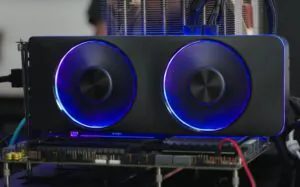
Earlier last week, Intel provided the world with a glimpse of the mid-range ARC A750 (it’s since been made private). Then, at the start of this week, the chipmaker’s Fellows, Tom Petersen and Ryan Shrout, officially unboxed the A770 Limited Edition, showing off the card’s design. Recently, the latter’s performance was further disclosed via a newly released video on Linus Tech Tips’ YouTube channel.
As he did during his WAN show, the A770 was tested under the watchful gaze of Petersen and Shrout, but more importantly, the Canadian TechTuber was given a chance to test not one, but two of the same GPUs, each running on different APIs. More on that in a short while.
Now, because the A770 has yet to officially be released, and for that matter, an unreleased product, there were some usual parametres that needed to be met before Linus was able to test it. Basically, both systems had to be diconnected from the internet, data collection had to be disabled, and he should “avoid” showing any FPS counters of any kind. Sort of, for the last point.
With that out of the way, let’s return to the previous point of the A770s, which are the APIs and the hardware they are paired with. Both GPUs are shown to be running off identical hardware; the CPUs are Intel’s more powerful Core i9-12900KS, and they are paired with 32GB of DDR5 RAM running at 4800MT/s. What sets them apart is that one system is running games on DirectX 11 and the other on DirectX 12, with both initially running the Shadow of the Tomb Raider benchmark.

As pointed out by Linus, the disparity between the systems and their APIs were like the sun and moon. For the A770 running the in-game benchmark with DX12, the GPU was averaging around 75 fps, while the system running on DX11 was performance far worse, at around 34 fps average.
As to why this was the case, Shrout explains that this is because Intel’s ARC team “targetted” new standards hard, and that the GPU AV1 encode and decode support, plus the lightweight driver, are “very good” at speaking directly to the GPU hardware in DX12 and Vulkan.
But that isn’t to say that Intel is abandoning the older DirectX APIs altogether. On that topic, Petersen explains that Intel is implementing what it descibes as a three-tier strategy for game optimisation. For Tier-1 titles, these games will work “exceptionally” well with ARC GPUs and if you managed to watch the A750’s brieft performance demo, you’ll know that Intel has kind of earmarked some of the currently existing titles for said tier. That includes Borderlands, Control, Cyberpunk 2077, and F1 2021, the last two being the titles that were used in LTT’s demonstration.

Moving down the list, Tier-2 titles will encompass titles that are less optimised for ARC, but are based on, once again, the DX12 and Vulkan APIs. Meaning that with just a little bit of tweaking from Intel’s side, and the games that fall under this tier should theoretically run well.
The main concern about optimisation, however, arises for Tier-3 titles, which only go up to DX11 for their API support. Even worse, a quick look at the Steam Charts shows that the top-five titles, which include CS:GO and PUBG, all fall under the Tier-3 classification. To further complicate matters, Intel didn’t exactly specify when game within the Tier will be properly optimised.
Getting back to the A770: again, Linus was able to showcase the performance of the card with DX12 by playing Cyberpunk 2077, while the card’s settings were reportedly set on the High preset and running at 1440p (2560 x 1440). While there was no FPS counter, the man estimated that the game was running between 50 and 60 fps, which is more or less the same as the A750 that Shrout showed off. Adding to that, Linus also managed to run the A770 running F1 2021, to which the game managed to sustain an average 180 fps at its “High” preset and the same 1440p resolution.

Interestingly, while Intel did not technically allow Linus to show any benchmarks, the screenshot of the Xtreme Tuning Utility showed that the A770’s GPU was, at the time, running at a boost clock of 2502MHz and pulling as much as 190W off the wall. That said, it should also be noted that the software itself is buggy and Intel will undoubtedly have to make further tweaks and fixes to it before the official launch of the card.
Intel’s ARC A770 Limited Edition is expected to be made available by the third quarter of this year but as it stands, China is going to be the first country to receive it then, while the rest of the world waits, perhaps until the following quarter before we are able to get our hands on it.
(Source: LTT, Tom’s Hardware, Videocardz)
The post Intel ARC A770 Graphics Card Performance Shown Off appeared first on Lowyat.NET.
